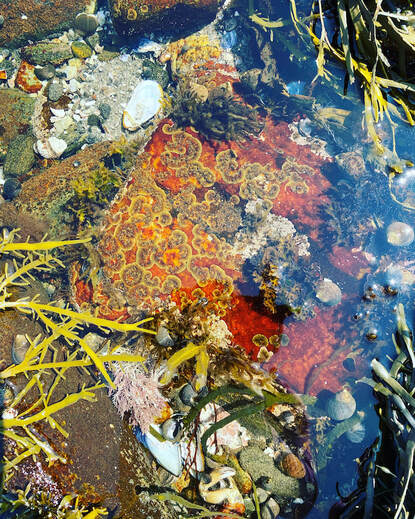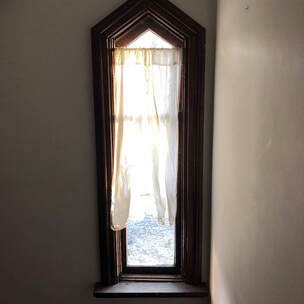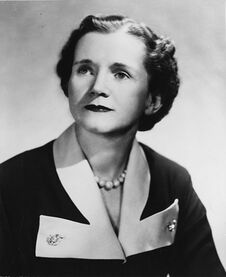|
6/27/2023 0 Comments Immerse Yourself Coralline algae, limpets, and periwinkles at the Rachel Carson Salt Pond Preserve Bristol, Maine Coralline algae, limpets, and periwinkles at the Rachel Carson Salt Pond Preserve Bristol, Maine If I was to listen to advice from Rachel Carson while writing my novel I would imagine she'd tell me to immerse myself in the places I want to write about. I've always done that, with all of my books. So no surprise I spent a week in Maine combing the same beaches she did while working on her book The Edge of the Sea (1956), and in her final years, Silent Spring (1962). I wanted to see what she saw as a fervent observer of the natural world. Rachel used the money gained from her fame as an author of the sea trilogy to buy a house on Maine's mid-coast. It was there she met and continued her special relationship with Dorothy Freeman. No wonder her cottage was a refuge, the Maine coast is picturesque and mysterious. On the day we arrived in Southport for our short mid-June vacation, a fog was creeping up the Sheepscot River into the small cove where we stayed. My husband thought it was smoke and asked "where's the fire?" That night he insisted we watch the 1980 movie The Fog to remember the creepy feeling of watching the mist roll in like a creature from another world. Perfect for a horror flick. I read somewhere the locals call it the vapors. That's making it into my novel. Then there's the tide pools. I grew up around freshwater lakes. In fact, I was eighteen when I first saw the ocean and even then my experiences have been limited to the sandy beaches of the Jersey Shore or Florida (one stint snorkeling a coral reef in Kauai). Rachel Carson was late to the ocean as well. She landed a summer scholarship to the Woods Hole Oceanographic Institute after college and this launched her passion to write about the sea. It's in her third book, The Edge of the Sea, she really puts her observational skills to work. Her explanation of the reproductive habits of the sea creatures is amazing, yet it's her vivid descriptions of the tidal pools, and colorful characteristics of the shifting, brimming with life ecosystems, that shine in this work. I went to the Rachel Carson Salt Pond Preserve to see what was so special about this place she called her summer home. The place where, I imagine, she allowed herself to observe, write, collect her thoughts without worldly distractions. Almost as if Lindbergh's Gift From the Sea was written about her. You have to have patience and dexterity to navigate the large boulders of the tidal pools in Maine's mid-Coast. The rocks are upended from geological faults so that they appear to have been pushed onto shore by a giant hand creating an accordion effect. The rocks glaze with crystalline striations of mica and quartz. Once I conquered the rocks, I found small pools where the ocean is trapped for a few hours while the tide is out. My view lands on a rock coated in red, submerged in a small pool of water. I identified it as coralline algae, a red algae that can secrete lime and encrust the surface of rocks. There were clumps of cladophora that resemble green mermaid hair until you pick it up and the strands feel like slime. And the rockweeds. While I was examining the tidal pools, I noticed on shore, some visitors, sitting in chairs, on the beach, on their phones. And I wondered. What is it? Why isn't this important enough? I know venturing onto treacherous rocks is not everybody's gig; I feel lucky I still can. But why not put that phone away and observe everything else? The gulls swooping in to devour whatever crabs or urchins they can discover amongst the rockweeds, the moaning of an ebbing sea, the faint clang of a line on the masthead of a sailboat moored offshore. The tidal pools in Maine made me step into a mode where I was present, not wondering what was happening later, where we'd eat dinner, just being. There's a story here that needs to be told and the only way to write it is to remember that feeling. Author note: I'll be running a workshop for Writers in the Mountains November 4th 2023 at their annual retreat on creating setting and place for your novel.
0 Comments
11/27/2022 0 Comments Wax Poetic In her acceptance speech for the National Book Award, Rachel Carson said this: "...no one could write truthfully about the sea and leave out the poetry." Which was why her book The Sea Around Us (1951) was so popular. Rachel had the knack for making the sea sexy. Of course, anyone who has visited the ocean is drawn to the undulating tides, but not everyone understands the machinations and the life forms dependent on them. Rachel describes it all in vivid detail. How the tides are drawn to the moon, following its waxing and waning, rising and falling with its cycles. One can visualize the neap tides, when the pull of the moon is in equilibrium with the sea and the highs and lows are not far apart. And the spring tides, twice monthly, when the moon is new or full, and the tides are at their highest. Rocks had "glistening backs...laid bare at low water." Waves are "armed with stones and fragments of rock." Her description of fog while aboard the research vessel The Albatross has an eeriness of a horror movie: "Day after day, the Albatross moved in a small circular room, whose walls were soft gray curtains and whose floor had a glassy smoothness. Sometimes a petrel fluttered across this room, entering and leaving it by passing through its walls, as if by sorcery. Evenings, the sun before it set was a pale silver disc hung in the ship's rigging, the drifting streamers of fog picking up its diffused radiance. The sense of a powerful presence felt but not seen, made manifest but never revealed, was far more dramatic than a direct encounter with the current." Her description of the grunion fish mating habits made me want to travel to California to witness it. But her words were enough to evoke the image of "shimmering" fish flinging themselves onshore on the crest of a wave. And once onshore, they lay "glittering" on the wet sand to mate. They bury their eggs before catching the next wave to return to the ocean - leaving behind their offspring. It's truly an art to distill the essence of an emotion, a place, an event in a format that is both brief and eloquent. While her musings on the sea explain the technicalities, she brings the reader to a place where even the most minute organism holds a profound secret for all. Ending her essay titled The Sea: Wind, Sun and Moon in The New Yorker, Rachel describes how the tiny worm Convoluta, no matter where placed will not forget the tidal rhythm of its being. This book was vindication for Rachel after the dismal failure of Under the Sea Wind. The New Yorker published a few chapters of The Sea Around Us pre-publication and by the time the book came out, readers were eager for more. In fact, publishing the chapters in serial format most likely propelled the book to best seller status. It stayed on the New York Times Best seller's list for 31 weeks, hitting number one. It sold over a million copies and was translated into 28 languages. I've been told once my writing allows people to feel as if they are right there in the scene. I've also had a reader ask me why my work sometimes reads commercial and other times literary. Not all readers have the patience to divert their attention from the plot to a string of words that makes them pause for a moment to savor. I'm ok with that. In fact, reading Rachel's work makes me think I may be on the right path for my next novel featuring her as one of the characters. Sources: Carson, Rachel. The Sea: Wind, Sun, and Moon. June 16, 1951. The New Yorker Carson, Rachel. The Sea Around Us. 1951. Brooks, Paul. 1989. Rachel Carson: The Writer at Work. 11/16/2022 0 Comments Stay Focused As I procrastinate on my next novel, I think back at how invested both financially and emotionally I've been to my writing life. I traveled everywhere to research the Durant Family Saga, and when I decided I wanted to turn it into a tv series, I took a course on screenwriting. I dedicated about a year to the effort, attending webinars, placing scripts in contests, paying for feedback, etc., etc. I'm pretty determined when I want to be. In fact, I've a few notebooks filled with ideas for new plots, novels, short stories and screenplays. I thrive on the creative work. But I never know what to expect from it. It's hard at times not to compare my experience with more successful authors. Rachel Carson grew up knowing the world expected something from her. In a college essay she claimed to be seeking a "fuller determination of her dreams." And she did it all without social media. She did it because she stayed focused. Although not one to pursue materialistic enterprises, her ambition did lead to financial freedom for her and her family. She grew up in Springdale, Pennsylvania in a small home with no running water or electricity. Even though the family was broke, her parents (most of all her mother) believed she had something special to contribute to the world and encouraged her to attend college. Rachel's laser sharp focus on her studies may well have been due to the fact they were always scrambling to come up with the $300 tuition to the Pennsylvania College for Women (now Chatham University), at one point selling off their dish-ware. When selling the family goods didn't prove enough, her father agreed to put up parcels of land he owned as collateral to the school. By the time Rachel graduated in 1929 she owed the college $1500.00. Her father lost his land. She went on to attend graduate school and ended up caring for her ill father, mother, and sister who was twice divorced with two daughters. They all crammed into an apartment in Baltimore where she attended Johns Hopkins University. To keep the family fed she took a job as a lab assistant in the medical school maintaining a colony of rats and fruit flies. It still wasn't enough. A friend visiting them at their cramped apartment found the family hovering over a bowl of fruit for dinner. Rachel pursued research at Woods Hole in Massachusetts where she discovered her passion for all things having to do with the Sea. She was always drawn to writing (she entered contests at an early age) and it was her ability to convey the wonders of the ocean to a lay audience that eventually propelled her to fame. But it took time. And Rachel didn't allow her family obligations to distract her from her goals. If anything, the financial turmoil she faced made her more determined than ever to make a living wage from her talents. Source: Souder, William. 2012. The Life and Legacy of Rachel Carson. 11/14/2022 0 Comments Write Slow Rachel Carson Date unknown. Wikimedia/Smithsonian Collection Copyright unknown. Rachel Carson Date unknown. Wikimedia/Smithsonian Collection Copyright unknown. When people ask me what I'm working on, I tell them I'm writing a novel set on the Maine coast that centers around a young protagonist pretending to assist Rachel Carson (1907-1964) with her research in order to impress a boy. Inevitably people ask me, who is Rachel Carson? If you ever studied environmental science, as I have, you would know Rachel is famous for her non-fiction Silent Spring (1962) which upended the chemical industry, made people aware that the Bald Eagle was at risk of extinction, and is credited with STARTING the environmental movement. And I've come to learn from reading one of the many biographies about her, she was a slow writer. Yay! Something to emulate. Because the idea for writing this story has been brewing in my mind for well over three years now. I've collected all of her books, read a tome of personal letters she exchanged with her best friend Dorothy and visited the Inn along the coast of Maine where her ashes were scattered. Yet I only just started writing the novel. It's not like me to take this long. I've published five novels in the span of ten years and have three completed works, in draft form sitting on my laptop (one will never be published - it's that bad). But for some reason, I'm only at 1600 words for this novel and the motivation to write it is paralyzed by my motivation to get it just right. I'm embarking on this blog to educate and excite the reading public, to draw attention to this woman scientist, a quiet revolutionary, so I can procrastinate. Join me! And learn more about this remarkable woman and her work. Source: Souder, William. 2012. The Life and Legacy of Rachel Carson. |
AuthorHi, I'm an author of contemporary and historical fiction. My next novel features a young protagonist from a lobstering family living on an island in Maine who pretends she's doing research for Rachel Carson to impress the people in her small town. Join me as I procrastinate writing the novel by blogging about Rachel. Archives
July 2024
CategoriesAll A Sense Of Wonder DDT Dorothy Freeman Environmental Movement Failure Rachel Carson Silent Spring The Edge Of The Sea The Sea Around Us Writing Writing Life |
|
|
All materials Copyright 2022
Any reproduction, reprint or publication without written consent of author prohibited. |
 RSS Feed
RSS Feed